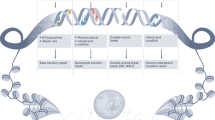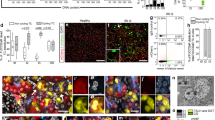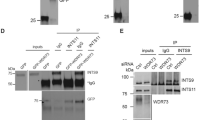Abstract
Chronic kidney disease (CKD) represents a major health burden1. Its central feature of renal fibrosis is not well understood. By exome sequencing, we identified mutations in FAN1 as a cause of karyomegalic interstitial nephritis (KIN), a disorder that serves as a model for renal fibrosis. Renal histology in KIN is indistinguishable from that of nephronophthisis, except for the presence of karyomegaly2. The FAN1 protein has nuclease activity and acts in DNA interstrand cross-link (ICL) repair within the Fanconi anemia DNA damage response (DDR) pathway3,4,5,6. We show that cells from individuals with FAN1 mutations have sensitivity to the ICL-inducing agent mitomycin C but do not exhibit chromosome breakage or cell cycle arrest after diepoxybutane treatment, unlike cells from individuals with Fanconi anemia. We complemented ICL sensitivity with wild-type FAN1 but not with cDNA having mutations found in individuals with KIN. Depletion of fan1 in zebrafish caused increased DDR, apoptosis and kidney cysts. Our findings implicate susceptibility to environmental genotoxins and inadequate DNA repair as novel mechanisms contributing to renal fibrosis and CKD.
This is a preview of subscription content, access via your institution
Access options
Subscribe to this journal
Receive 12 print issues and online access
$209.00 per year
only $17.42 per issue
Buy this article
- Purchase on Springer Link
- Instant access to full article PDF
Prices may be subject to local taxes which are calculated during checkout





Similar content being viewed by others
Accession codes
References
Coresh, J., Astor, B.C., Greene, T., Eknoyan, G. & Levey, A.S. Prevalence of chronic kidney disease and decreased kidney function in the adult US population: Third National Health and Nutrition Examination Survey. Am. J. Kidney Dis. 41, 1–12 (2003).
Mihatsch, M.J. et al. Systemic karyomegaly associated with chronic interstitial nephritis. A new disease entity? Clin. Nephrol. 12, 54–62 (1979).
Kratz, K. et al. Deficiency of FANCD2-associated nuclease KIAA1018/FAN1 sensitizes cells to interstrand crosslinking agents. Cell 142, 77–88 (2010).
Liu, T., Ghosal, G., Yuan, J., Chen, J. & Huang, J. FAN1 acts with FANCI-FANCD2 to promote DNA interstrand cross-link repair. Science 329, 693–696 (2010).
MacKay, C. et al. Identification of KIAA1018/FAN1, a DNA repair nuclease recruited to DNA damage by monoubiquitinated FANCD2. Cell 142, 65–76 (2010).
Smogorzewska, A. et al. A genetic screen identifies FAN1, a Fanconi anemia–associated nuclease necessary for DNA interstrand crosslink repair. Mol. Cell 39, 36–47 (2010).
Hildebrandt, F., Benzing, T. & Katsanis, N. Ciliopathies. N. Engl. J. Med. 364, 1533–1543 (2011).
Hildebrandt, F. et al. A systematic approach to mapping recessive disease genes in individuals from outbred populations. PLoS Genet. 5, e1000353 (2009).
Otto, E.A. et al. Candidate exome capture identifies mutation of SDCCAG8 as the cause of a retinal-renal ciliopathy. Nat. Genet. 42, 840–850 (2010).
Palmer, D., Lallu, S., Matheson, P., Bethwaite, P. & Tompson, K. Karyomegalic interstitial nephritis: a pitfall in urine cytology. Diagn. Cytopathol. 35, 179–182 (2007).
Burry, A.F. Extreme dysplasia in renal epithelium of a young woman dying from hepatocarcinoma. J. Pathol. 113, 147–150 (1974).
Zollinger, H.U. et al. Nephronophthisis (medullary cystic disease of the kidney). A study using electron microscopy, immunofluorescence, and a review of the morphological findings. Helv. Paediatr. Acta 35, 509–530 (1980).
Spoendlin, M. et al. Karyomegalic interstitial nephritis: further support for a distinct entity and evidence for a genetic defect. Am. J. Kidney Dis. 25, 242–252 (1995).
Baba, F., Nanovic, L., Jaffery, J.B. & Friedl, A. Karyomegalic tubulointerstitial nephritis—a case report. Pathol. Res. Pract. 202, 555–559 (2006).
Godin, M. et al. Karyomegalic interstitial nephritis. Am. J. Kidney Dis. 27, 166 (1996).
Verine, J., Reade, R., Janin, A. & Droz, D. Karyomegalic interstitial nephritis: a new French case. Ann. Pathol. 30, 240–242 (2010).
Knipscheer, P. et al. The Fanconi anemia pathway promotes replication-dependent DNA interstrand cross-link repair. Science 326, 1698–1701 (2009).
Auerbach, A.D. Fanconi anemia and its diagnosis. Mutat. Res. 668, 4–10 (2009).
Auerbach, A.D. & Wolman, S.R. Susceptibility of Fanconi's anaemia fibroblasts to chromosome damage by carcinogens. Nature 261, 494–496 (1976).
Yoshikiyo, K. et al. KIAA1018/FAN1 nuclease protects cells against genomic instability induced by interstrand cross-linking agents. Proc. Natl. Acad. Sci. USA 107, 21553–21557 (2010).
Simons, M. et al. Inversin, the gene product mutated in nephronophthisis type II, functions as a molecular switch between Wnt signaling pathways. Nat. Genet. 37, 537–543 (2005).
Huangfu, D. et al. Hedgehog signalling in the mouse requires intraflagellar transport proteins. Nature 426, 83–87 (2003).
Otto, E.A. et al. Mutations in INVS encoding inversin cause nephronophthisis type 2, linking renal cystic disease to the function of primary cilia and left-right axis determination. Nat. Genet. 34, 413–420 (2003).
Zhou, W., Dai, J., Attanasio, M. & Hildebrandt, F. Nephrocystin-3 is required for ciliary function in zebrafish embryos. Am. J. Physiol. Renal Physiol. 299, F55–F62 (2010).
Schäfer, T. et al. Genetic and physical interaction between the NPHP5 and NPHP6 gene products. Hum. Mol. Genet. 17, 3655–3662 (2008).
Sayer, J.A. et al. The centrosomal protein nephrocystin-6 is mutated in Joubert syndrome and activates transcription factor ATF4. Nat. Genet. 38, 674–681 (2006).
Liu, T.X. et al. Knockdown of zebrafish Fancd2 causes developmental abnormalities via p53-dependent apoptosis. Dev. Cell 5, 903–914 (2003).
Zeng, Z., Richardson, J., Verduzco, D., Mitchell, D.L. & Patton, E.E. Zebrafish have a competent p53-dependent nucleotide excision repair pathway to resolve ultraviolet B–induced DNA damage in the skin. Zebrafish 6, 405–415 (2009).
Chaki, M. et al. Exome capture reveals ZNF423 and CEP164 mutations, linking renal ciliopathies to DNA damage response signaling. Cell (in the press).
Koeners, M.P., Braam, B., van der Giezen, D.M., Goldschmeding, R. & Joles, J.A. A perinatal nitric oxide donor increases renal vascular resistance and ameliorates hypertension and glomerular injury in adult fawn-hooded hypertensive rats. Am. J. Physiol. Regul. Integr. Comp. Physiol. 294, R1847–R1855 (2008).
Mallette, F.A. & Ferbeyre, G. The DNA damage signaling pathway connects oncogenic stress to cellular senescence. Cell Cycle 6, 1831–1836 (2007).
Moch, H., Spondlin, M., Schmassmann, A. & Mihatsch, M.J. Systemic karyomegaly with chronic interstitial nephritis. Discussion of the disease picture based on an autopsy case. Pathologe 15, 44–48 (1994).
Kruglyak, L., Daly, M.J., Reeve-Daly, M.P. & Lander, E.S. Parametric and nonparametric linkage analysis: a unified multipoint approach. Am. J. Hum. Genet. 58, 1347–1363 (1996).
Strauch, K. et al. Parametric and nonparametric multipoint linkage analysis with imprinting and two-locus–trait models: application to mite sensitization. Am. J. Hum. Genet. 66, 1945–1957 (2000).
Gudbjartsson, D.F., Jonasson, K., Frigge, M.L. & Kong, A. Allegro, a new computer program for multipoint linkage analysis. Nat. Genet. 25, 12–13 (2000).
Bentley, D.R. et al. Accurate whole human genome sequencing using reversible terminator chemistry. Nature 456, 53–59 (2008).
Otto, E.A. et al. Mutation analysis in nephronophthisis using a combined approach of homozygosity mapping, CEL I endonuclease cleavage, and direct sequencing. Hum. Mutat. 29, 418–426 (2008).
Koeners, M.P., Braam, B., van der Giezen, D.M., Goldschmeding, R. & Joles, J.A. Perinatal micronutrient supplements ameliorate hypertension and proteinuria in adult fawn-hooded hypertensive rats. Am. J. Hypertens. 23, 802–808 (2010).
Acknowledgements
We are grateful to the families and study individuals for their contribution. We thank A. Francois (Rouen) for contribution of pathology data and J. Amatruda (UT Southwestern) for antibodies. This research was supported by grants from the US National Institutes of Health to F.H. (DK068306), E.A.O. (DK090917) and W.Z. (DK091405), by the Burroughs Wellcome Fund Career Award for Medical Scientists and by Doris Duke Charitable Foundation Clinical Scientist Development Awards to A.S. W.Z. is a Carl W. Gottschalk Scholar of the American Society of Nephrology (ASN). A.S. is a Rita Allen Foundation Scholar and an Irma T. Hirschl Scholar. F.H. is an Investigator of the Howard Hughes Medical Institute, a Doris Duke Distinguished Clinical Scientist and a Frederick G.L. Huetwell Professor. This research was supported by grants from the European Union Seventh Framework Programme FP7/2009 under grant agreement 241955, SYSCILIA and the Netherlands Organization for Scientific Research to R.H.G. (NWO Vidi-917.66.354). This work used two Core facilities at the Michigan Diabetes Research and Training Center funded by DK020572 from the US National Institute of Diabetes and Digestive and Kidney Diseases.
Author information
Authors and Affiliations
Contributions
W.Z. performed all zebrafish studies. E.A.O., A.C., K.D., H.Y.G., T.W.H., M.C., A.K.G., S.N., S.J.A., S.J., G.R. and F.H. prepared and evaluated exome sequences. A.C., K.D., and F.H. identified mutations in the human FAN1 gene. F.P.L. performed the breakage and cell cycle analysis. A.S. and G.R.B. performed protein blotting in subject cell lines. A.S., G.R.B. and U.V. performed sensitivity assays. S.T. performed epistasis analysis. J.W. carried out genomic mapping. S.L. performed exome capture and massively parallel sequencing. R.A., T.W.H., M.C. and A.K.G. characterized antibodies. G.G.S., J.A.J., R.G. and R.H.G. performed γH2AX histochemistry. A.C., K.D., J.D., F.B., M.S., H.M., M.J.M., A.F., J.V., R.R., H.S., M.G., D.K., G. Monga, G. Mazzucco, K.A., F.A., R.C.N., T.W., S.Z., T.B.H. and F.H. recruited patients and gathered detailed clinical information for the study. F.H. conceived of and directed the project and wrote the paper together with A.S.
Corresponding authors
Ethics declarations
Competing interests
The authors declare no competing financial interests.
Supplementary information
Supplementary Text and Figures
Supplementary Tables 1–3 and Supplementary Figures 1–6 (PDF 6949 kb)
Rights and permissions
About this article
Cite this article
Zhou, W., Otto, E., Cluckey, A. et al. FAN1 mutations cause karyomegalic interstitial nephritis, linking chronic kidney failure to defective DNA damage repair. Nat Genet 44, 910–915 (2012). https://doi.org/10.1038/ng.2347
Received:
Accepted:
Published:
Issue Date:
DOI: https://doi.org/10.1038/ng.2347
This article is cited by
-
Karyomegalic interstitial nephritis as a rare cause of kidney graft dysfunction: case report and review of literature
BMC Nephrology (2023)
-
Pathological consequences of DNA damage in the kidney
Nature Reviews Nephrology (2023)
-
Altered DNA methylation in kidney disease: useful markers and therapeutic targets
Clinical and Experimental Nephrology (2022)
-
New familial cases of karyomegalic interstitial nephritis with mutations in the FAN1 gene
BMC Medical Genomics (2021)
-
Karyomegalic interstitial nephritis: diagnosed only when suspected
Surgical and Experimental Pathology (2021)



